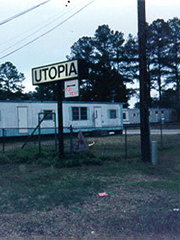Spatial Practices is a traveling, field-based seminar that asks questions of the meaning, economy, and politics of the built environment. This summer's field-school will be organized around the spatial and social utopias of America, with an eye toward the way belief, ideology, and aspiration shape settlement patterns in the American landscape. The architecture and planning of the utopian communities we will visit provide a material lens through which to view changing attitudes towards nature, modernity, urbanization, and social belonging. While many of these sites have since annulled their explicitly utopian beginnings, these sites still carry what Walter Benjamin provocatively referred to as a 'secret index' or a 'weak messianic power' of their past.
As used here, 'utopias' refers to a suite of spatial practices--where industrial town planning, religious and communitarian societies, and techno-transcendental visions all intermingle. The common thread that unites these visions across space and time is their intentional, comprehensive, and ideological orientation. As such, we will be researching a range of planned communities--from the religio-social utopias of the 19th century to the techno-anarchic utopias of the 20th; from the intellectual aspirations of New Harmony to the autarkic ambitions of Biosphere 2. By charting a radical genealogy of urban and architectural practices through the American landscape--one that engages with a broader political, social, and technological matrix--we can see the emerging contours of a new type of historical space.
This field-school will be on the road for the duration of the seminar--traveling in vans, conducting field-recordings at various utopian sites, and researching the broader cultural landscape in which these communities are situated within and in distinction to. Participants will be introduced to a range of readings that situate these sites within a broader discourse of society and space--ranging from classical texts such as Plato's Republic and Moore's Utopia, through to 19th+20th century cautionary tales of utopia gone awry, and into Foucault's Heterotopic formulations. Throughout, we will return to a set of key architectural and urban texts that will help situate our on-the-ground research and provide a lens through which we can more effectively cultivate a reading of our milieu.
|
